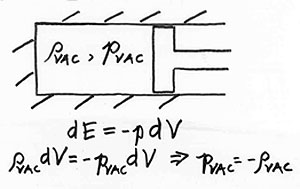
 |
| Turner |
The discovery of cosmic speedup, perhaps one of the most important in all of science over the past 25 years, saved a beautiful theory--inflation--and presented theorists with a wonderful puzzle--"dark energy," the stuff causing cosmic speedup. What more could we ask for?
Since 1980, Alan Guth's cosmic inflation has been the driving idea in cosmology. Central to inflation is a very early, tremendous burst of expansion, powered by the potential energy associated with a hypothetical scalar field called the inflaton. In a tiny fraction of a second, a small bit of the universe is blown up to a size that encompasses all that we can see today and much, much more. Any spatial curvature becomes flattened, and quantum fluctuations in the inflaton field are stretched from subatomic to astrophysical size. The decay of the inflaton produces the heat of the Big Bang, and the quantum fluctuations in it lead to the matter inhomogeneity that provides the seeds for all the structure in the universe, from galaxies to clusters of galaxies and beyond.
Inflation not only explains, it also predicts. Its predictions include: a spatially flat universe, a pattern of anisotropy in the cosmic microwave background (CMB) that arises from the quantum-produced density perturbations, and a sea of gravitational waves. Inflation was the inspiration for the very successful cold dark matter (CDM) scenario for how structure formed. CDM theory is based on a flat universe, dark matter made of slowly moving elementary particles, and density perturbations arising from quantum fluctuations.
 |
Inflationists (like me) pinned our hopes on growing evidence for enormous amounts of dark matter that hold galaxies and clusters of galaxies together. This dark matter is distributed more diffusely than stars, making it harder to inventory. Estimates for W0 rose, and for a while it appeared that enough dark matter would be found to meet the inflationary prediction.
By 1990, the problems for a flat universe were piling up. Estimates of the amount of dark matter were getting better and still falling short, and observations of large-scale structure suggested a CDM universe with a matter density that was one-third of the critical density, that is, WM = 1/3. Several of us sheepishly made a suggestion1 to save inflation: Add a cosmological constant, L, for the missing two-thirds of the critical density, WL= 2/3. Thus W0=WM+WL = 1. The inflationary prediction is a flat universe, not necessarily WM = 1.
To save a beautiful theory, theorists are willing to consider the implausible, although not the impossible. With its checkered history in cosmology, the cosmological constant was certainly implausible. Albert Einstein used it to create a static model of the universe; Hermann Bondi, Thomas Gold, and Fred Hoyle used the cosmological constant to address the fact that the time back to the Big Bang appeared to be less than the age of Earth, and now it is invoked to save inflation.
By the mid-1990s, the observational evidence for the L version of CDM, including the first hints from CMB anisotropy measurements that the universe is flat, was becoming compelling, at least for theorists.1 However, there was a problem: LCDM (CDM with a cosmological constant) also predicts accelerated expansion, and the first supernova results did not yet show acceleration.
With the discovery of cosmic speedup in 1998, everything quickly fell into place: The universe is flat, with one-third in matter and two-thirds in something like a cosmological constant. Overnight, skeptical astronomers became believers in inflation. Strange as it was, cosmic speedup was the missing piece in the puzzle. It saved inflation, but be careful what you wish for!
According to Isaac Newton, gravity is always attractive, because the strength of an object's gravity depends only on its mass. Einstein's theory, however, allows for repulsive gravity and cosmic speedup because the strength of gravity also depends on pressure, p, with r + 3p acting as the source of gravity. Something that is very elastic (that is, negative pressure p < -r / 3) has gravity that repels, rather than attracts.
Something with pressure comparable to its energy density is exotic. Matter, even at the center of a sun, has a pressure that is orders of magnitude smaller than its energy density. The ratio of pressure to energy density is characterized by the square of the internal velocity divided by c2. Thus dark energy is intrinsically relativistic and is more like energy than matter. Even though repulsive gravity sounds like fun, dark energy--as far as we know--can't be bottled up to create an object with antigravity.
Quantum mechanics provides a candidate for something that is very elastic: The virtual pairs that fill the vacuum have negative pressure. To see this, compute the pdV work done by an expanding piston that encloses quantum vacuum; you will find that pvac= - rvac where rvac is the quantum vacuum's energy density (see the figure). Thus, quantum vacuum energy is very repulsive because r + 3p = -2 rvac. Mathematically, quantum vacuum energy is equivalent to Einstein's infamous cosmological constant.
Although Einstein dismissed the cosmological constant as a personal blunder, quantum mechanics makes it obligatory. Unfortunately, even the best quantum "mechanics" have failed to produce a sensible prediction for L. The sum of zero-point energies diverges due to short-wavelength modes. Truncating at an energy scale beyond which we can appeal to physics ignorance illustrates the enormity of the problem: For a 100-GeV cutoff, WL= 1055. This disparity is the greatest embarrassment in all of theoretical physics.
Many particle theorists believe that a correct calculation of L will yield precisely zero because of the utter implausibility of obtaining a number 55 or more orders of magnitude smaller than its "natural value." If quantum nothingness weighs nothing, what, then, is causing the universe to accelerate? Dark energy!
What do we know about dark energy and how can we learn more? It accounts for about two-thirds of the critical energy density and is much more smoothly distributed than matter. If it clumped, we would see its effects when studying clusters and other gravitationally bound objects, and we do not. Dark energy is characterized by an "equation of state," which is the ratio w (pronounced "dubya") of its pressure to its energy density w = p/r. Although w need not be constant, for simplicity I will assume that for now.
If dark energy is vacuum energy, w = -1 (for comparison, for nonrelativistic matter w = 0, and for radiation, w = 1/3.) The ratio w determines how the energy density of dark energy changes as the universe expands: r µ 1/R3(1+w), where R is the cosmic scale factor. Negative pressure (w < 0) leads to an energy density that decreases more slowly than matter ( rM µ 1/R3). Because of this fact, dark energy was less important in the past and will become more important in the future. Why dark energy is just becoming important today begs for explanation. I call this the Nancy Kerrigan problem--why me, why now?
That dark energy was unimportant in the past is good: This fact means the repulsive gravity of dark energy doesn't interfere with the attractive gravity of dark matter that drives the formation of cosmic structure. The lesser importance of dark energy in the past is also the root of an independent argument for cosmic acceleration. The "missing energy" needed in addition to matter to account for the flat universe determined from CMB measurements (see the story on page 21) must have been unimportant in the past; otherwise its smooth distribution would have interfered with the formation of structure. To make the missing energy unimportant in the past requires that w < -1/2, which implies that it must have repulsive gravity.
Imaginative theorists have suggested an array of possibilities for dark energy. Many involve the existence of a new, scalar field and the idea that we are in a period of mild inflation while this field (called quintessence) rolls toward its ground state. Because quintessence and inflation both involve accelerated expansion and the underlying cause of each is poorly understood, it has been speculated that they might be related. Thus far, quintessence has raised new questions without shedding light on dark energy.
What we call dark energy could be the harbinger of exotic physics rather than a new, etherlike substance. Cosmic acceleration could be signaling that Einstein's theory requires modification, perhaps due to the influence of unseen additional spatial dimensions. An interesting twist is that some string theorists believe that cosmic speedup and string theory, which itself predicts extra dimensions, are incompatible. This will come as a relief to the less enthusiastic fans of string theory.
One thing is clear: Dark energy leads to a revision in our view of cosmic destiny. With matter alone, destiny and geometry are one: Closed universes recollapse and open or flat universes expand forever. If dark energy is vacuum energy, our flat universe will continue accelerating to a bleak future--in 100 billion years all but a few hundred galaxies nearby will have their light shifted too far into the red to be seen. If dark energy eventually dissipates, the universe will begin to decelerate, possibly even recollapse.
Because dark energy is so diffuse, cosmology offers the only known way of getting at it, and w is the hook. The energy density of dark energy, which depends on w, affects the expansion rate. Models for dark energy differ in their predictions for w and thus in their predictions for the expansion history of the universe. Distant supernovae, galaxy clusters, and gravitational lensing can all be used to chart the past expansion rate and determine w. And there is much interest in doing so: Two new centers--the Kavli Institute for Particle Astrophysics and Cosmology at Stanford University and the NSF Center for Cosmological Physics at the University of Chicago--list the study of dark energy as a primary science goal. The US Department of Energy is planning a dedicated space telescope for supernovae, the SuperNova/ Acceleration Probe (SNAP). NASA has targeted dark energy for one of its new Einstein probes. NSF is considering an 8-m wide-field survey telescope to study dark energy, the Large-aperture Synoptic Survey Telescope (LSST). Add in my nine-year-old son's theoretical work, and progress is assured.
Dark energy is one of the deepest and most exciting puzzles in all of science. It is likely that a crazy new idea is needed to explain cosmic speedup and resolve the cosmological constant problem. (That does not mean every crazy idea is a solution.) The payoff will be well worth the effort: We will gain new insights into the nature of matter, space, and time, and shed light on our cosmic destiny.